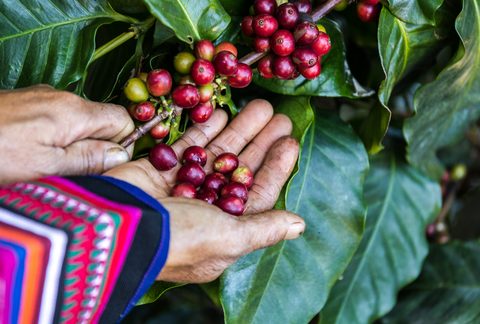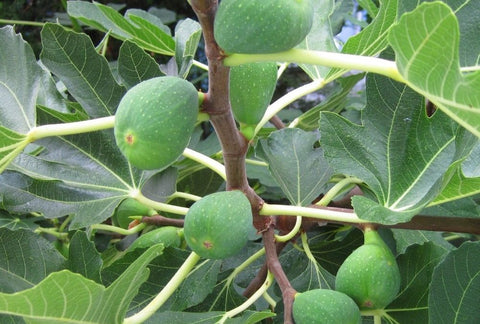A goat herder discovered coffee in Ethiopia in 850 AD after observing that the goats had a lot of energy and did not sleep at night after eating the coffee fruits.

Timing
Harvest from Year 2+ on.

Part sun
Equivalent of 4+ hours of direct sun [DLI of 12+ mol/m²/day].

Care
Intermediate. You’ll transplant, prune, and harvest.
Best Coffee varieties to grow inside.
Coffee has 124 varieties. We have listed the top 4 most popular varieties that you can grow indoors:
Arabica
The most popular and highest quality brew. Used in most types of coffee as well as a flavoring for desserts and other drinks.
AmazonRobusta
Has a greater crop yield than arabica, contains almost twice the caffeine, and is less susceptible to pests and disease
Wheelin Pete’s Green CoffeeCoffea liberica
Can taste very sweet and fruity. Although different from Arabica, it is very tasty. Mostly found in Southeast Asia.
Lens Coffee
Best Setup for Coffee Plants
You’ll need:
Planter:
A pot that is at least 8″ / 1 gal, though there is some flexibility. The plant will grow in proportion to its planter – so size is based on how tall you want your plant to grow.
Soil:
Standard Potting Mix
Plant Food:
Balanced Blend. This should be equal parts nitrogen, phosphorus, and potassium (with NPK numbers like 10-10-10).
Grow Light:
A strong grow light that can give the equivalent of 4+ hours of direct sun [DLI of 12+ mol/m²/day].
Jump to: Our product recommendations
Starting your Coffee: Seed vs Propagate
Coffee that’s grown to eat is usually started with a live plant or cutting. This is because plants grown from seeds will grow as “wild types” – meaning they won’t produce the same fruit they came from (think of crab apples!).
Why you shouldn’t start Coffee from seed
If you grow a Coffee from seed, it won’t grow “true to type” meaning the fruit you will get will be a weird cross between the many different varieties – and chances are it won’t taste very good. This is why Coffee seeds arent really available
Propagating Coffee: How to Clone from a Stem Cutting

If you’ve already got a Coffee plant you love (or a friend does!) you can easily “clone” it with just sharp scissors and a clean glass of water. First, cut a couple 6” shoots of new growth (avoid anything woody). Next, remove the lower leaves, so the bottom half is just stem. Place in a glass of 3” of water, making sure the cut leaf spots are underwater. Place the glass on a bright windowsill and change the water every few days. In a couple of weeks, roots should emerge and you can transplant them into your container. While using additional rooting hormones won’t hurt, it’s not necessary with Coffee plants.
- Cut 6” section of new growth
- Remove leaves halfway and place them in the water on a sunny window sill
- Wait 75 days for a few ½ inch roots to form and carefully transplant into it final container
How to Transplant Coffee

Live starter plants give you a big jump start on your first harvest. When you’re in a garden center – pick the bushiest plant available (tall and lanky ones will be weak growers) and give it a good inspection for pests. Leaves should be dark green without holes, spots, or curled edges. A best practice is to actually “quarantine” your plant for about a week after bringing it home to make sure it’s free and clear of ride-on pests.
Ensuring its pest and disease-free it’s time to transplant your seedling into its final home.
- Remove some soil from its final planter – leaving enough space for the bottom of the seedling to be just higher than the soil surface.
- Hold on to the base of the stem with one hand, and turn the pot over while gently pulling the seedling. Giving the pot a few squeezes can help dislodge it.
- Place in its final container and fill around it with soil so that it’s tight, but not compacted.
Where to grow your Coffee plants
Out of all edible plants, Coffee plants have some of the lowest light needs – but they still need to be in a very bright place that gets at least 4+ hours of direct sunshine. While you might be lucky enough to have a bright windowsill that works, most of us need to use a grow light (especially during the winter). For an introduction to grow lights, head over to our post on grow lights for indoor gardeners. We’ve also got a buying guide for screw in types, but to keep things simple in this guide, we’ll just provide directions for the 24W Screw in Bulb by Sansi, which we think is a good middle-of-the-road option.

How bright should your grow light be?
Coffee plants need the equivalent of 4+ hours of direct sunlight [DLI of 12+ mol/m²/day] to grow their best. In order to provide an equivalent amount with a grow light, it needs to be pretty bright! The 24W Sansi bulb should be placed 6 inches away from the top of the plant. This will give your PPFD (the standard measure of brightness) of 500 μmol/m²/s.
How many hours per day do your Coffee plants need under a grow light?
Coffee plants are known as “short-day,” meaning they’ll develop faster if they sense over 12 hours of darkness. We want them to progress into flowering as soon as possible, so we recommend setting up a timer to leave it on for only 8 hours per day.
Coffee Plants Grow Faster in Warmer Temps
Coffee plants are native to tropical regions and like lots of heat, classifying them as “warm weather crops”. Sunnier and south-facing windows help keep things warmer – ideally 80°F but anything between 60 and 90°F is fine.
How to Prune Coffee Trees

Pruning is important for Coffee trees. Even dwarf varieties can easily grow up to 15 feet – and pruning keeps them easier to manage, care for, and fit in our living space. Beyond this, we help the plant focus its energy by limiting the number of branches we allow to develop. The basics of pruning are simple; plants grow from their tips (not bottom), but if you remove the tip it will redirect the growth to side branches. The art of pruning takes many forms, however – Bonsai, Espalier, and Spur are some ways the basic principles are applied. We encourage you to explore the look you want, but if you are unsure, open-center pruning is a well established style for fruit trees.
The standard for most fruit trees is known as “Open Center Pruning” where the canopy consists of 3 or 4 evenly spaced main branches. This lets light and air penetrate through the center and reach the edges for an even, lush plant. Make the first cut when you are happy with the height of the trunk – it may happen as soon as you get your plant (we recommend letting the trunk be at least 2 ft above the soil). This cut should be right above a bud or branch coming off the main trunk. This will encourage the main branches to form, so if more than 3 or 4 come out then remove the extra with an eye to keep spacing even. The main pruning is now done, so just once or twice a year you’ll want to do a maintenance prune to remove any crossing or dead branches and keep the center short.
Year 1+: How to Pollinate Your Coffee Flowers

Coffee plants are self-fruitful, so there is no need to pollinate the flowers (though if you do – you can expect 25% more berries). After the flowers form, it generally takes 6 to 7 months to ripen.
Year 2+: How to Harvest Coffee
The coffee bean that we know (and love) is the seed that grows inside something called the Coffee Cherry. You’ll know the cherry is ripe because it will plump out and turn red, yellow, orange, or pink. The cherry is totally edible and quite delicious – it is sweet as honey and depending on the variety it can have flowers of manjo, berries, or jasmine. It takes about 400 coffee beans (there’s 2 per cherry) to make a cup of coffee – but if your up for it save and roast the beans for a cup of truly home-brewed coffee.
Year 20+: End of Life
While coffee plants can live for 100 years, they are most productive between years 7 and 20 -as long as they are kept in favorable conditions.
Shop This Blog
The right supplies can take the guesswork out of caring for your plants – and turn care from a daily to weekly routine. Through our grow tests, we’ve found these products to produce the best indoor Coffee (and also have simple maintenance). Plants are adaptable and can grow in many different conditions, so they are by no means necessary if you already have other supplies.
Best Containers for Coffee: Ceramic Self Watering Planters
Plants thrive on consistent moisture but can suffer if they’re waterlogged. A semi-porous ceramic self regulates ideal conditions. Our favorite is the COSWIP planter. Runner up is XS Self Watering Planter by Wet Pot.
Best Soil for Coffee: Standard Potting Mix
Coffee likes a rich and moist root zone – so you are best off with a standard potting mix – we like this Organic Mix by Espoma.
Best Nutrients for Coffee: Balanced Blend
Coffee likes nutrients that are equal parts nitrogen, phosphorus, and potassium (with NPK numbers like 10-10-10). For a Balanced Blend we recommend: Dr Earth All Purpose
Best Light for Coffee: DIY or Soltech
There is a very small chance that you have the bright windows needed to grow these without a grow light. If you are looking for a higher-end option – we love the Aspect Light by Soltech. For a more affordable option, a DIY setup using a 24W Screw-in Bulb by Sansi with a Clamp Light and Mechanical Timer works well too. Check out our complete guide on a DIY setup for less than $40 or our buying guide for screw in bulbs.










There are no comments for this article. Be the first one to leave a message!